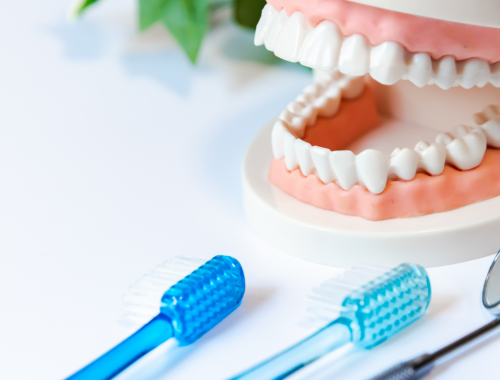Difference Between Pericoronitis and Periodontitis
Pericoronitis is when there is an inflammatory response of the gum of a particular tooth that hasn’t fully moved through the gum. Periodontitis is when there is widespread inflammation of the gums that affects all the teeth.

What is Pericoronitis?
Definition:
Pericoronitis is when there is an inflammatory reaction that occurs over a piece of gum found near a tooth that is starting to push through the gum.
Causes and prevalence:
Bacteria and food particles can be trapped on the gum near a tooth that hasn’t fully made its way through the gum. This can result in inflammation of the area overlying the tooth. It most commonly occurs when wisdom teeth start pushing through the gumline. About 95% of cases of pericoronitis are believed to occur with wisdom teeth even though other teeth can be affected.
Symptoms and complications:
The person will feel pain and the area will be red and swollen; there may also be pus present. A fever may also develop.
Diagnosis:
The condition is diagnosed by a physical exam of the mouth and area that is affected.
Treatment:
Treatment can involve a dentist removing the debris and affected tissue. Sterile saline can be used to wash the area and antibiotics and pain killers can be prescribed. In some cases, surgical extraction of the tooth may be indicated and the best solution.

What is Periodontitis?
Definition:
Periodontitis is a condition where there is inflammation of the gums surrounding all the teeth.
Causes and prevalence:
The cause of periodontitis is incorrect and inadequate brushing and flossing of the teeth. Some people are at greater risk such as older people, people with diabetes, AIDs, or Crohns disease. Smoking also increases the risk of periodontitis. The condition is fairly common, with about 19% of people affected world-wide.
Symptoms and complications:
The symptoms of periodontitis include bad breath and painful gums, and gums that are red and bleed often. In severe cases, the gums may retract and teeth may simply fall out.
Diagnosis:
The diagnosis of periodontitis is by a dental examination and sometimes, by x-rays taken of the mouth showing the teeth and gums.
Treatment:
Pericoronitis can be treated by cleaning out the area with sterile saline and using antibiotics; the affected tooth or teeth may need to be extracted. Periodontitis can be treated with a professional cleaning of the teeth and gums; sometimes using antibiotics is indicated to prevent infection from worsening.
Difference between Pericoronitis and Periodontitis?
Definition
Pericoronitis is when there is local inflammation on the gum of a new tooth. Periodontitis is a severe inflammatory reaction of the gums.
Teeth affected
Wisdom teeth (3rd molars) are most often affected. Any teeth can be affected but the most likely to be badly affected are the bottom front teeth.
Symptoms
The symptoms of pericoronitis includes the following: pain, swollen gum tissue, pus, fever, trismus, swelling of the face and lymph nodes of the neck. The symptoms of periodontitis include the following: pain, swollen, red, and bleeding gums, bad breath, and loose teeth.
Causes
An accumulation of food and bacteria on the gum surrounding the tooth can lead to pericoronitis. Improper brushing and flossing of the teeth can lead to periodontitis.
Complications
Complications of pericoronitis includes the formation of an abscess, which can cause widespread infection. Complications of periodontitis includes the formation of abscesses on the gums, and teeth loosening up and falling out.
Treatment
Rinsing with sterile saline solution, pain killers, antibiotics, and surgical removal of the tissue or tooth will help in the treatment of pericoronitis. Professional cleaning of the teeth, antibiotics, and sometimes tooth removal is how periodontitis is treated.
Table comparing Pericoronitis and Periodontitis

Summary of Pericoronitis Vs. Periodontitis
- Pericoronitis and periodontitis are both conditions involving inflammatory responses of the gums.
- Periodontitis is a widespread infection and inflammation.
- Pericoronitis affects only one or a few teeth, and most often these are the third molars (wisdom teeth).
- Antibiotics are used to treat both pericoronitis and periodontitis.
FAQ
How do you identify pericoronitis?
The best way to identify that you have pericoronitis is to visit a dentist who can take x-rays and examine your mouth.
When should I see a dentist for pericoronitis?
You should see the dentist if you have symptoms of bleeding gums, pain, and fever.
What does severe pericoronitis look like?
The gums surrounding one or more wisdom teeth are swollen, red, painful, and oozing pus.
Is pericoronitis hard or soft?
Pericoronitis is a soft tissue infection.
What will a dentist do for pericoronitis?
The dentist will clean out any bits of food from the area and give you antibiotics. In some cases, the wisdom tooth or teeth may need to be removed, especially if they are impacted or have grown in at an odd angle.
How urgent is pericoronitis?
It is urgent because the infection can spread and cause life-threatening sepsis. You should seek treatment as soon as possible if you think you may have pericoronitis.
- Difference Between Rumination and Regurgitation - June 13, 2024
- Difference Between Pyelectasis and Hydronephrosis - June 4, 2024
- Difference Between Cellulitis and Erysipelas - June 1, 2024
Search DifferenceBetween.net :
Leave a Response
References :
[0]Kwon, Gloria, and Marc Serra. "Pericoronitis." StatPearls [Internet]. StatPearls Publishing, 2022.
[1]Ubertalli, James T. “Gingivitis”. Merckmanuals. Merck & Co., 2022, https://www.msdmanuals.com/professional/dental-disorders/periodontal-disorders/gingivitis
[2]Ubertalli, James T. “Periodontitis (Pyorrhea”. Merckmanuals. Merck & Co., 2022, https://www.msdmanuals.com/home/mouth-and-dental-disorders/periodontal-diseases/periodontitis
[3]Image credit: https://www.canva.com/photos/MADC1pMSW5M-periodontal-disease/
[4]Image credit: https://www.canva.com/photos/MAEEctXpYhQ-periodontal-disease/
